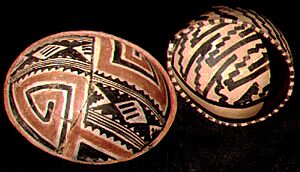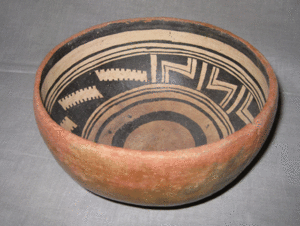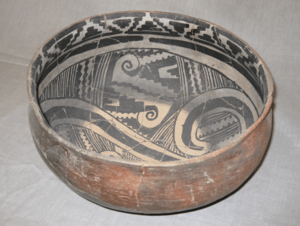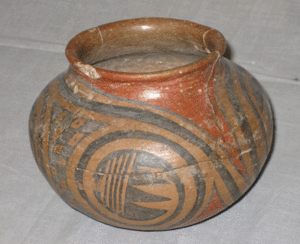Roosevelt Red Ware facts for kids

Roosevelt Red Ware is a type of ancient pottery found in parts of Arizona and New Mexico. It is also known as Salado Red Ware or Salado Polychrome. This pottery style uses red, white, and black paint in different patterns. It also has special shapes and materials. This type of pottery was made from about AD 1280-1290 until at least AD 1450. We know these dates from tree-ring dating.
History of Roosevelt Red Ware
Archaeologists have studied Salado pottery for a long time. They want to know if it represents a group of people or a set of ideas that spread across the Southwest. Some archaeologists prefer the name "Salado Polychromes." This is because they don't want to focus too much on the Roosevelt Lake area. People once thought this area was where the pottery was first made. Both "Salado Red Ware" and "Roosevelt Red Ware" are still used today.
One archaeologist, Dr. Patricia Crown, studied what the Salado Polychromes meant. She thought they might be:
- Important items for leaders.
- Signs of a trade network.
- Connected to a religious movement.
- Used by groups of people who moved to new areas.
She believed the pottery first appeared in villages where people from northeastern Arizona had moved. She also thought it spread with a religious movement. This movement encouraged peaceful trade and sharing of ideas between different groups. More recently, archaeologists like Lyons (2003) have looked at where these pottery types are found. They suggest the pottery marks where groups of people from northeastern Arizona moved.
Types of Roosevelt Red Ware Pottery
Archaeologists divide Roosevelt Red Ware into different types. These types help them understand shorter time periods. They look at the painted designs and the shapes of the bowls.
Roosevelt Red Ware has three main types based on their style. Recently, researchers at Archaeology Southwest found six more types. These new types are based on both style and shape. For bowls with designs inside and outside, the outside style is called the "variant." For example, a bowl with a Gila design inside and a Tonto design outside is called "Gila Polychrome: Tonto Variant."
All types of this pottery share some general features. The clay is usually brown to reddish-brown. It often has sand mixed in. Red or white slip (a thin coating of liquid clay) covers the inside and outside. Black paint is used on one or both surfaces. This black paint is usually surrounded by white slip, not red. The black paint is often made from plants. Sometimes it's a mix of plant and mineral paint. Studies show that Roosevelt Red Ware was made in all the areas where it is found.
Pinto Polychrome Pottery
Pinto Polychrome is the oldest type of Roosevelt Red Ware. It was made from about AD 1280 to 1330. Pinto Polychrome pottery is only found as bowls. It does not have the "banding line" that you see on Gila Polychrome. The designs on Pinto Polychrome are similar to St Johns Polychrome. They often have solid and hatched (cross-lined) patterns. This type shows a time when potters were trying out new colors and designs.
Pinto Polychrome is found in many places. These include the Mogollon Rim in Arizona, the Tonto Basin, Sierra Ancha, and the San Pedro Valley. It's also found near Point of Pines, Kinishba, and the Upper Gila Valley.
Some experts have noted a type called Pinto-Gila Polychrome. This is a mix between Pinto and Gila styles. It has bolder designs like Gila Polychrome but no banding line. It is still only found in bowls. Some archaeologists don't use this type. They say that pottery styles often blend during transition times. Pinto Polychrome also has a "Salmon Variety."
Pinto Black-on-red Pottery
This type is similar to Pinto Polychrome in dates, designs, and where it's found. The main difference is that Pinto Black-on-red does not have the white slip under the black paint.
Gila Polychrome Pottery
Gila Polychrome is the first type in this group to be found as both bowls and jars. Gila Polychrome has bolder designs than Pinto Polychrome. Bowls are easy to spot because of a banding line just below the inside rim. Jars have wide stripes of white slip with black designs. The bottoms of the jars are usually still red. Sometimes jars have many parallel black-on-white bands. These are separated by thin red slip bands. The "Salmon Variety" of Gila Polychrome has a pinkish slip instead of white. Otherwise, it looks similar.
Gila Polychrome was made from about AD 1300 to 1450. It is found across Arizona, New Mexico, and northern Mexico.
Gila Black-on-red Pottery
This type is similar to Gila Polychrome in dates, designs, and where it's found. But it does not have the white slip under the black paint.
Tonto Polychrome Pottery
Tonto Polychrome is found more often on jars. The black-on-white designs are usually narrower bands or panels. These designs are surrounded by red slip. This type started later than Gila Polychrome, around AD 1340, and ended around 1450.
Cliff Polychrome Pottery
Cliff Polychrome has special styles and shapes that make it different from Gila Polychrome. It was made from about AD 1300 to 1450.
This type is found as bowls. It often has rims that curve back or flare out a bit. With this change in bowl shape, the banding line is lower. This creates a second design area between the banding line and the rim. The designs themselves are similar to those on Gila and Tonto Polychrome pottery.
Cliff Polychrome is found from Petrified National Forest, Arizona, to Casas Grandes, Chihuahua, Mexico. It also ranges from the Phoenix basin to Alamogordo, New Mexico. It seems to have been made most often in southeastern Arizona and southwestern New Mexico. This might be where it first appeared.
Nine Mile Polychrome Pottery
Nine Mile Polychrome is like Cliff Polychrome. It is only found as bowls with a curved rim. It has a black-on-white design band on the inside of the bowl, just below the rim. This is the area above the banding line on Cliff Polychrome. But unlike Cliff Polychrome, the rest of the inside of Nine Mile Polychrome is red. It does not have any other designs or a banding line. Usually, Nine Mile Polychrome bowls have Gila or Tonto Polychrome designs on the outside. This type is found from the Cliff Valley to Perry Mesa. It also extends from the Middle Verde Valley to the area around Douglas, Arizona. This pottery is rare, but it is most common in the far southeastern part of its range. It dates from AD 1375-1450.
This pottery type is named after the Nine Mile Site in the San Simon Valley.
Phoenix Polychrome Pottery
Phoenix Polychrome is also found only as bowls with curved rims. It is similar to Nine Mile Polychrome. The difference is that Phoenix Polychrome does not have the black-on-white design band inside the bowls. Instead, the entire inside is covered in red slip. Like other types, the outside of these bowls might have Gila or Tonto style designs.
This type dates from AD 1375-1450. As its name suggests, it is mainly found in the Phoenix basin. But it also extends east to the Cliff Valley. Its range goes from the Verde Valley in the north to the Douglas, Arizona area in the south.
Dinwiddie Polychrome Pottery
Dinwiddie Polychrome is another type defined by bowls with curved rims. It dates from AD 1375-1450. The designs on this type are only on the outside of the pottery. The inside is "smudged," meaning it has a dark, shiny black surface.
Dinwiddie Polychrome is found in a very small area. It may not be found west of a line drawn through Kinishba, near Whiteriver, and the Nine Mile site, near Bowie, Arizona. In her 1994 study, Dr. Crown noticed that Roosevelt Red Ware bowls with smudged insides were only found in a limited area.
Los Muertos Polychrome Pottery
Los Muertos Polychrome has been known by archaeologists for a long time. It was first noted as a type of Gila Polychrome in 1927. It has been called many names, like Gila Polychrome with four colors, Las Colinas Polychrome, and Perry Mesa Polychrome.
This type uses red paint along with black paint in white design areas. The design patterns are either Gila or Tonto styles. So, it is often referred to as a variety of those. This pottery is found in the Verde Valley, the Agua Fria-Perry Mesa area, and the Lower Salt River Valley. It's also in the Middle Gila, the Santa Cruz Flats, and the Tonto Basin.
Cliff White-on-red Pottery
Cliff White-on-red is also a type of Roosevelt Red Ware bowl with a curved rim. The inside of the pottery is smudged. The outside has white-on-red designs. Cliff White-on-red is found in the same areas as Dinwiddie Polychrome. This means it's found in southwestern New Mexico and southeastern Arizona.
Other white-on-red pottery types exist in the Southwest. But Cliff White-on-red is unique enough to be its own type. It is different from Gila White-on-red because Cliff White-on-red is thinned by scraping, not by paddling. Also, its designs have broader lines. Salado White-on-red is different because it has white designs on a red-slipped corrugated (wavy) body. Finally, Tularosa White-on-red is most similar to Cliff White-on-red. It also has a smudged inside and a curved rim. But Tularosa White-on-red has two to four coils around the neck and thinner lines in its designs.
Mexican Pottery Forms
In their study of Casas Grandes, DiPeso, Rinaldo, and Fenner (1974) named a pottery type called Escondida Polychrome. While not officially a Roosevelt Red Ware, it shares many features. Escondida Polychrome is made with local clay, a buff-colored clay used for types like Ramos Polychrome. It has black and red designs, and many patterns are similar to Roosevelt Red Wares. However, this type does not have the white slip found on Roosevelt Red Ware. Its designs also show influence from pottery made in Chihuahua, Mexico. Escondida Polychrome might be a mix of Roosevelt Red Wares and Chihuahuan pottery. It was likely made in northern Mexico.
There is another unnamed type similar to Escondida Polychrome. This type does have the white slip found on Roosevelt Red Ware. Experts believe these pots were likely Roosevelt Red Wares made locally. They would be grouped under one of the types mentioned above. However, pieces of this pottery would have the buff-colored clay found in that region.
|






